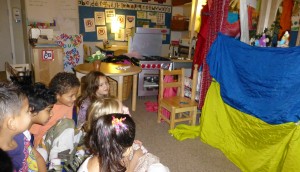“I can’t do it!”
“Can you tell me what to write?”
“I don’t know how to write.”
Pre-Kindergarten children frequently utter some mighty disparaging words. One of our first tasks in Pre-K involves teaching young children what writing really is. We must show them that four-year-old children write in many different ways. For instance, each of the lines below say, “I love my mom.”

All of these (and many more) are ways that English speaking young humans communicate through printed symbols. We often take it for granted that drawings are a way of writing. What is a drawing if not an abstract symbol of a more concrete object or idea? A child who is “drawing pictures” when asked to “write” is still showing you that he or she knows a lot about writing. They know that the marks they make on paper can be a way of delivering information.
The second line contains what many would call “scribbles,” but an attuned eye would notice the similarity to text in our own culture. The horizontal placement and combination of curves and straight lines reflects a child’s experiences with printed text. Imagine looking at a piece of work written in an unknown language using an unknown system of symbols to communicate meaning. Your first attempts to recreate it from memory would probably appear a bit like scribbles, too. It is a normal progression of development for children to express themselves through scribbles and pictures to help them communicate their knowledge or feelings through writing.
Next in the line up is the line of “letter-like symbols.” The child is getting closer to understanding and recalling the shapes used in our written language, but form and directionality are not necessarily obvious to the child yet. Babies spend a large amount of time learning that an object remains the same no matter what is done to it. A blanket can be flat, rolled up, right-side up or torn in half and it is still a blanket. When we throw letters and numbers into the mix, children find directional rules perplexing. It takes time, experience and brain growth to accept and understand the special rules for writing.
The next step is actually missing from the image above. It would include a string of random letters. Children who write in this way know that the shapes of the letters are important. They are simply still working on the idea that the order of the symbols changes the meaning of the text.
The next developmental progression has a pre-requisite. In the example “ILM” the child is using the first letter-sound in each word to represent the entire word. Before a child can write in this way, he or she must have lots of experience identifying beginning sounds in spoken words. A child writing in this manner shows me that they understand some of the auditory relationships between spoken and written language.
The second to last example tells us that the child is beginning to hear some middle and ending sounds in words, as well. Another possibility is that the child is not yet hearing vowels (the most difficult to discern), but does have a few traditional spellings memorized, such as “mom.”
The final example is written in traditional “adult print.” It contains all of the letters and spaces an adult would use. Pre-K children are not expected to get here by the end of Pre-K. Most Kindergarten students will not be here by the end of next year. Of the few Pre-K and K students I’ve worked with who were reading at a first or second grade level, none were writing like adults on a consistent basis. They are not supposed to. Their brains just aren’t there yet. It is O.K.
For the first few weeks of school, we focus on convincing the children that they CAN write. They are Pre-K children and are expected to write like Pre-K children. Once we succeed it is much easier to help them progress. You can help in a couple of ways:
- Positively recognize attempts to communicate through writing and drawing
- Remind your child that he or she is NOT a grown-up
- Choose to accept approximations of writing as valid forms of communication
- Let your child see you make mistakes. We ARE adults. We are NOT perfect.









